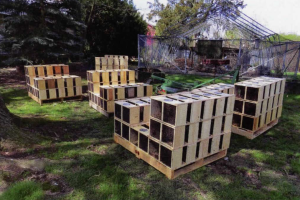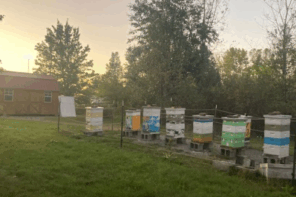By: David Riddle
This article originally appeared in the Autumn 2018 issue of BEEKeeping Your First Three Years
In Hemmingway’s story an old man catches a big fish and battles the sea and the creatures therein to bring the fish home and show it off. The reviewers sometimes say it is a battle of mankind with nature or mankind with the ocean. Perhaps it is a battle with the old man and himself. The irony is that in the end there is nothing left, but the old man still won the battle.
The old man in my story (myself) started his adventure with the bees at 65 years of age. He was and still is able to lift a 90 # deep box, but how long that will be the case is in doubt. Already over shoulder height supers are a problem. Learning about bees originally was believed to be an intellectual enterprise. Dead bees proved “that just ain’t so”. Becoming a NC Master Beekeeper doesn’t seem to impress those ladies either.
A couple of friends and I took a beginner beekeepers class that lasted nine weeks. After that and a lot of time on Bee Source I knew almost everything there was to know about bees except how to get honey and how to keep them alive through the Winter and a couple of other minor things. Bee school taught that there should be two colonies to start with. Experience teaches that there should be at least three. At least with three a frame of brood can be rob bed from one colony to help a queenless colony. Resources are just too scarce with two colonies. The addiction feature of beekeeping has gotten my colony count up to over 30.
Fortunately medium nucs were available locally. Mediums seemed like the best way to go. That is another of those things that changed with experience. The bees had a wonderful Summer. They took the sugar water they were given and made lots of beautiful honey that was only good for bees. Treating with chemicals was something that an organic gardener would never do, so in the Winter, the bees went the way of that other old man’s fish. They did leave a lot of sugar honey and drawn comb though.
The best thing about bee school was getting a mentor. In this old man’s case, there were two mentors, Karen Bryzki and Dietlinde Zipkin. There was also a bonus in the form of their mentor Frank Clements. The mentors and the dead bees helped me learn how much I didn’t know. Karen and Dietlinde are still performing that function.
So here comes year two. More bees were ordered. Before they came an exterminator friend ran across a swarm. It was a great introduction to swarm catching. They were hanging off of a bush about two feet off the ground. A homemade bee bucket and a pair of loppers caught the swarm which was happy to take up residence in the backyard. Three hives made 30# of honey. Oxalic acid came to the rescue for Varroa and two of the hives made it through the Winter. The old man had caught the fish, or maybe the fish had caught the old man.
 In the Meckbees club, mentoring at bee school earns one the privilege of being on the swarm list on the web page. Catching swarms took the apiary size up to 14 colonies. It also taught some lessons about swarms.
In the Meckbees club, mentoring at bee school earns one the privilege of being on the swarm list on the web page. Catching swarms took the apiary size up to 14 colonies. It also taught some lessons about swarms.
• Don’t stand under the swarm when shaking the branch on which it rests.
• Cut outs are hard. The captured colonies don’t have a good chance of living. Old men should have a young assistant. This old man doesn’t want to do them anymore.
• Trap outs are easier and more profitable. The bees still don’t have much chance of surviving though. The old man likes trap-outs.
• Bait hives are the best way to catch swarms other than scooping them off of a low hanging branch.
A cheap, easy to install, and effective bait hive was finally developed after studying the bait hives that others had built and making a few changes in designs. It was so successful that a workshop for building it was developed and presented at the NC/SC joint Spring meeting in 2017. The workshop was a raging success and had to be moved to a larger room in the convention hall. Two of the attendees have asked for the presentation to be made at their local bee clubs.
While year three was a success in the number of colonies, the honey yield was a bust. 10# was hardly worth extracting. The swarm hives did not survive well either. Year four started off with only three colonies of the 14 peak after swarm season. Two more colonies were obtained as nucs from someone who had brought them home from the almonds. Those colonies were fantastic and helped in the production of 200+ #s of honey. Becoming NC certified helped the honey sell for top dollar.
Four packages were also purchased that year. Two were from Texas and two were from a local source. Each set of two packages consolidated to become a single colony. Friends suggested that they had been “poured” from the same colony. The two colonies that remained were transferred to Brown Mountain on the edge of Pisgah National Forest with the hope of making sourwood honey. They did not make honey that year. They did survive the Winter.
 One would think than an extremely mild Winter would improve overwintering. There’s a catch there. Another bite taken from the fish. The bees did not stay inside watching soap operas and eating bonbons. They went out flying around on every pretty day. There were almost no sources of nectar so they ate up most of their stores. The sugar bricks prevented starvation but still left empty honey frames when Spring came.
One would think than an extremely mild Winter would improve overwintering. There’s a catch there. Another bite taken from the fish. The bees did not stay inside watching soap operas and eating bonbons. They went out flying around on every pretty day. There were almost no sources of nectar so they ate up most of their stores. The sugar bricks prevented starvation but still left empty honey frames when Spring came.
The nectar flow came early and wet. There was a lot of pollen and sugar water was fed to boost brood rearing. It was very late in the season when the bees started putting up surplus. Seven new colonies were purchased from the eastern part of the state. They had been on the almonds, but the provider had blueberry contracts to fulfill before the nucs could be released. Only one of these colonies is producing honey this year.
The NC Master Beekeeper program has been a real help. The program requires a great deal of learning but the real focus is on service. Almost every bee club in the state has some kind of beginner training that culminates in the certified beekeeper written test. In Mecklenburg the students are assigned mentors who administer a practical test and help the new beekeepers learn to get along with their bees.
The Journeyman program requires service requirements and a higher level of knowledge on the test. There is also a practical test that is administered by a journeyman or master level beekeeper. After one becomes a journeyman he can learn enough administering the test to new journeyman candidates to make passing the practical test for Masters a snap.
The Master’s certificate requires a lot more service events and some specialty items. These can be fulfilled by getting certified to administer epi-pen injections or be an insecticide applicator. So why would one want to apply insecticides. The beekeeper’s goal is to keep the girls alive. The old man did that one because it looked like low-hanging fruit for a specialty. It wasn’t as easy as it appeared. It does give a new appreciation of the role of pesticides in agriculture and indirectly helps keep bees alive.
To be a “real” beekeeper one must learn to graft and raise queens. I think this is one of those thing that is easier than it appears. It is not easy in that requires learning and persistence. It is extremely satisfying. There are several ways to make queens without grafting. Once one learns grafting these methods are less attractive. Grafting really does require a lot of resources. Woodenware, bees and time are the main items.
Brian Fischer taught a really good class on queen rearing. The old man tried a little grafting and determined that he was just too old. The NC state association started a new program called “Born and Bred” to teach queen rearing. That class taught a formula method of queen rearing. The two old mentors, Dietlinde and Karen teamed up with the old man and provided young eyes and confidence. Making queen cells wasn’t easy but we did it. A solution was found for the old eyes. Just don’t look.
So the queen rearing adventure began. The first two sessions with about 40 cups yielded 100% – failure. The third session yielded five queens. The excitement was fantastic, but the next three sessions yielded nothing. Little methodical changes did not help. There were wild queen cell in the cell builder every week so the cell builder technique was changed to exclude young larvae. Success – 18 queen cells.
The first five queen cells graduated from the queen castles. Four of them had successfully mated and had really nice laying patterns. These were placed in nucs. The bees from the unsuccessful castle were given a new queen cell. Although this year was intended to be for practice and building up resources, people have been wanting to buy the queens and the small colonies. The dollar return on time has been low, but all of the out or pocket costs have been covered with a small surplus.
The old man feels like a real beekeeper now even though he didn’t get honey this year.









